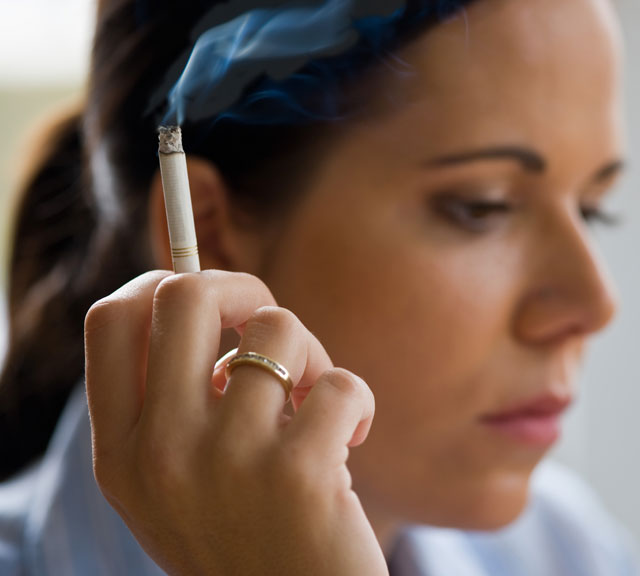The Top 9 Causes of Lung Cancer

Find Your Perfect Match
Answer a few questions and we'll provide you with a list of primary care providers that best fit your needs.
We’ve all known it for decades. The best way to avoid getting lung cancer is to quit smoking, or better yet, to never start.
Smoking causes about 90 percent of lung cancer deaths in men, and almost 80 percent in women. And yet, despite these well-publicized numbers, lung cancer remains the leading cause of death from cancer.
What are we not learning? What don’t we know? Below is a look at the leading causes of lung cancer, and what you need to know to avoid being one of those grim statistics.
1. Smoking
It’s simple. If you smoke, stop immediately. If you don’t smoke, don’t start.
“If you stop smoking before you get lung cancer, the damaged tissue in your lungs will gradually heal,” says Jennifer Clune, MD of Pulmonary and Critical Care Consultants, Inc. “This holds true regardless of your age or how long you’ve smoked.”
In fact, the American Cancer Society (ACS) reports that people who stop smoking before age 50 cut their risk of dying in the next 15 years in half, compared with those who continue to smoke. But the longer you smoke, the longer it will take for your lungs to heal, and some damage may be permanent.
Choosing cigars, pipes, or low-tar or “light” cigarettes, won’t make things better. These have almost or as much risk of causing lung cancer as cigarettes. Also, menthol cigarettes may pose an even greater risk, since the menthol allows smokers to inhale more deeply.
Ready to quit? Learn more about resources to help.
2. Second-hand Smoke
Smokers don’t just harm themselves; they put others at risk, too. “The people around you who are breathing in your smoke, at home or at work, have an increased risk of developing lung cancer by as much as 30 percent,” says Dr. Clune.
3. Radon
Radon is a naturally occurring, radioactive gas that results from the breakdown of uranium in soil and rocks. “The challenge with radon is that it cannot be seen, tasted or smelled,” Dr. Clune explains. According to the U.S. Environmental Protection Agency (EPA), radon is the second leading cause of lung cancer in this country, and is the leading cause among non-smokers.
Outdoors, in wide-open spaces and fresh air, radon is not likely to be dangerous. But radon can seep into houses built on soil or rocks containing uranium, and it can concentrate indoors. When radon is breathed in, it exposes the lungs to small amounts of radiation. This may increase your risk of lung cancer. If you are a smoker exposed to radon, the risk is even greater.
If you are concerned about radon exposure, you can use a radon detection kit to test the levels in your home, or contact a local or state office of the EPA for the names of reliable companies that can test and help fix the problem.
4. Asbestos
People who work with asbestos are at high risk for lung cancer. If you smoke and are exposed to asbestos, the risk from the two grows exponentially. Over time, government regulations have greatly reduced the use of asbestos in commercial and industrial products, but if you do work with or around asbestos, follow proper safety procedures.
Asbestos is still present in many homes and other older buildings, but it is not usually harmful as long as it is not released into the air by deterioration, demolition or renovation. If asbestos does need to be removed from your home, the ACS recommends that you hire a qualified contractor to perform this job to avoid contaminating your home further or exposing yourself or others. Do not attempt to remove it yourself.
5. Other Workplace Carcinogens
Other agents found in some workplaces that can increase lung cancer risk include diesel exhaust, radioactive ores (such as uranium), and a number of inhaled chemicals, including arsenic, beryllium, cadmium, silica, vinyl chloride, nickel compounds, chromium compounds, coal products, mustard gas and chloromethyl ethers.
If you work around these, limit your exposure when possible and follow proper safety procedures.
People who stop smoking before age 50 cut their risk of dying in the next 15 years in half.
6. Air Pollution
In cities, air pollution (especially near roads with heavy traffic) appears to raise the risk of lung cancer slightly. Some researchers estimate that up to five percent of all deaths from lung cancer, worldwide, may be due to outdoor air pollution.
7. Radiation Therapy
People who have had radiation therapy to the chest for other cancers, like Hodgkin’s disease or breast cancer, may be at higher risk for lung cancer, particularly if they smoke.
8. Personal or Family History of Lung Cancer
If you have had lung cancer in the past, you have a higher risk of developing another lung cancer.
Brothers, sisters and children of those who have had lung cancer may have a slightly higher risk, especially if the relative was diagnosed at a younger age. Genetics, and/or shared household exposures (like radon or tobacco smoke), may be at fault.
9. Marijuana Smoking
There are some reasons to believe that smoking marijuana might increase your risk of lung cancer. Marijuana smoke contains tar and many of the same cancer-causing substances that are in tobacco smoke. Marijuana smoke is also inhaled deeply and held in the lungs for a long time, which gives cancer-causing substances more opportunity to deposit in the lungs.
But those who use marijuana tend to smoke fewer marijuana cigarettes in a day or week than the amount of tobacco consumed by cigarette smokers. This would make it harder to increase lung cancer risk. But more research is needed to be certain.
Sometimes, No Clear Risk Factors
Finally, some people who get lung cancer do not have any clear risk factors. “Although we know how to prevent most lung cancers, we still don’t know how to prevent all of them,” concludes Dr. Clune. And while lung cancer often remains “silent” until it is well advanced, Dr. Clune recommends staying on top of your health by making healthy lifestyle choices and seeing your physician for regular wellness exams.
Find Your Perfect Match
Answer a few questions and we'll provide you with a list of primary care providers that best fit your needs.
Source: Premier Community Health; American Cancer Society; Centers for Disease Control; Environmental Protection Agency; Jennifer Clune, MD, Pulmonary and Critical Care Consultants, Inc.


